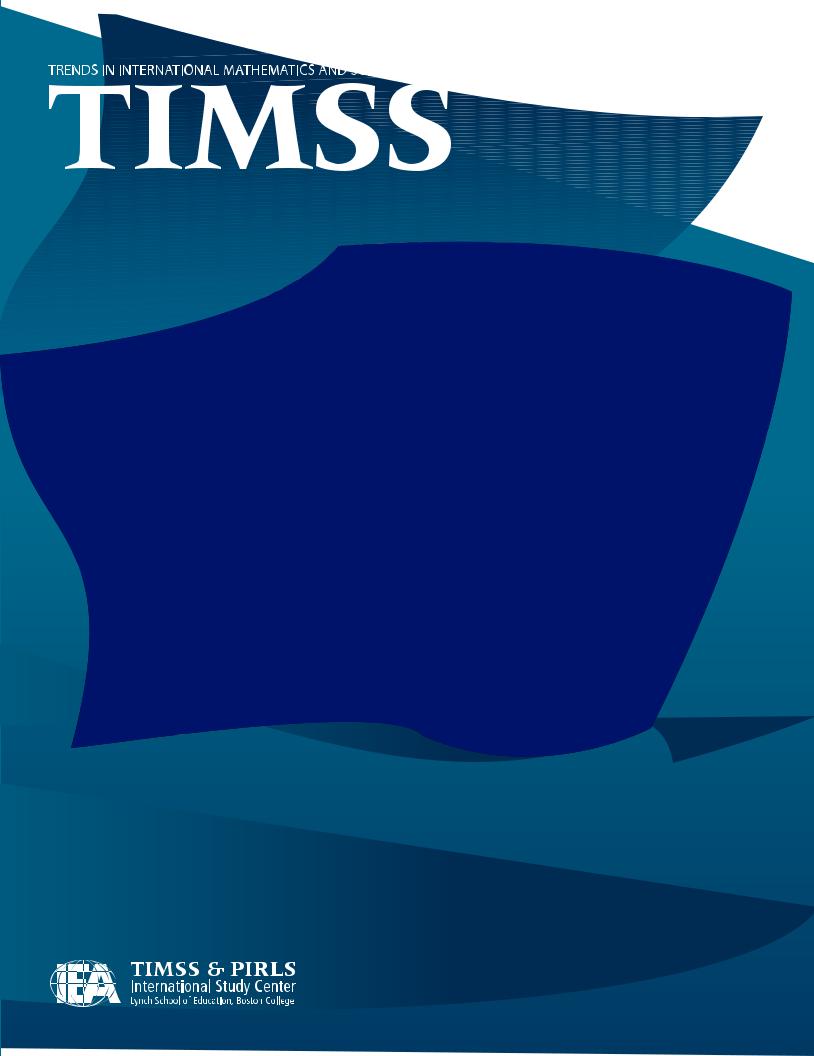
TIMSS2011_Frameworks
.pdf
TIMSS 2011
Assessment Frameworks
Ina V.S. Mullis, Michael O. Martin, Graham J. Ruddock, Christine Y. O'Sullivan, and Corinna Preuscho

TIMSS 2011
Assessment Frameworks
Ina V.S. Mullis
Michael O. Martin
Graham J. Ruddock
Christine Y. O'Sullivan
Corinna Preuschoff
September 2009
TIMSS 2011Assessment Frameworks
by Ina V.S. Mullis, Michael O. Martin,
Graham J. Ruddock, Christine Y. O'Sullivan, and Corinna Preuschoff.
Publisher: TIMSS & PIRLS International Study Center Lynch School of Education, Boston College.
© 2009 by the International Association for the Evaluation of Educational Achievement (IEA), Amsterdam, the Netherlands.
Library of Congress Catalog Card Number: 2009903161 ISBN: 1-889938-54-8
Printed and bound in the United States.
For more information about TIMSS: TIMSS & PIRLS International Study Center Lynch School of Education
Boston College
140 Commonwealth Avenue Chestnut Hill, MA 02467 United States
Tel: +1 617 552 1600
Fax: +1 617 552 1203 e-mail: timss@bc.edu http://timssandpirls.bc.edu
Boston College is an equal opportunity, affirmative action employer.
Contents
Foreword |
1 |
Introduction |
5 |
Chapter1 |
17 |
TIMSS 2011 Mathematics Framework |
|
Chapter2 |
47 |
TIMSS 2011 Science Framework |
|
Chapter 3 |
91 |
TIMSS 2011 Contextual Framework |
|
Chapter4 |
117 |
TIMSS 2011 Assessment Design |
|
References |
135 |
AppendixA |
145 |
Acknowledgements |
|
Appendix B |
159 |
Example Mathematics Items |
|
AppendixC |
173 |
Example Science Items

Foreword
Foreword
TIMSS (the Trends in International Mathematics and Science Study) is a truly global, cooperative enterprise involving more than 60 countries from all around the world. There is enormous diversity among the TIMSS countries—in terms of economic development, geographical location, and population size. However, all have a common desire to improve the mathematics and science education of their students, and the conviction that comparing education systems in terms of their organization, curricula, instructional practices and corresponding student achievement is an effective policy analysis tool.
TIMSS 2011 is the fifth in the series of TIMSS assessments. Since first being conducted in 1995, TIMSS has reported every four years on the achievement of fourth and eighth grade students in countries all around the world. Countries that have participated in successive waves of TIMSS (1995, 1999, 2003, 2007, and now 2011) have access to unparalleled information about the improvement or decline in the mathematics and science achievement of their students. Central to the success of TIMSS has been participating countries’ expertise in the areas of curriculum, measurement, and education, and their willingness to work together in the interests of improving mathematics and science education.
TIMSS is a project of the International Association for the Evaluation of Educational Achievement (IEA), an independent, international cooperative of national educational research institutions and governmental research agencies dedicated to improving education. IEA’s mission is to provide high quality information on
Foreword | 1
student achievement outcomes and on the educational contexts in which students achieve. Fundamental to IEA’s vision is the notion that the diversity of educational philosophies, models, and approaches that characterize the world’s educational systems constitute a natural laboratory in which each country can learn from the experiences of the others. Founded in 1959 for the purpose of conducting comparative studies focusing on educational policies and practices in countries around the world, IEA’s membership has since grown to include more than 60 countries. It has a Secretariat located in Amsterdam, the Netherlands, and a Data Processing and Research Center in Hamburg, Germany. IEA studies have reported on a wide range of topics and subject matters, each contributing to a deep understanding of educational processes within individual countries and within a broad international context.
The TIMSS 2011 Assessment Frameworks provides a template for IEA’s work in the assessment of mathematics and science at fourth and eighth grades. Building on the widely-accepted frameworks prepared for the 2007 assessment, this document is the product of an extensive collaborative process involving many individuals and expert groups from around the world, most notably the TIMSS advisory groups in mathematics and science and the National Research Coordinators (NRCs) of the more than 60 participating countries. The iterative process of consultation, collaboration, and systematic review among representatives of the TIMSS countries, the mathematics and science research community and other experts ensures that the document reflects the latest advances in thinking about large scale comparative assessment of mathematics and science and embodies the interests of many individuals and countries around the world.
Funding for TIMSS was provided by the National Center for Education Statistics of the U.S. Department of Education and the participating countries, with support from Boston College and the U.K.’s National Foundation for Educational Research.
The work presented in this document represents the efforts of many individuals and groups. TIMSS is directed by IEA’s
2 | Foreword
TIMSS & PIRLS International Study Center at Boston College, from which it derives the direction and leadership necessary to complete such a complex and ambitious project. Together with the committed and able staff from the consortium of organizations that work to implement TIMSS, including the IEA Data Processing and Research Center and Secretariat, Statistics Canada, and Educational Testing Service, the Center’s dedicated staff and consultants have played a vital role in developing the assessment frameworks. Crucial also has been the work of the TIMSS advisory groups in mathematics and science, and in particular that of TIMSS Mathematics Coordinator Graham Ruddock and TIMSS Science Coordinator Christine O’Sullivan. Working closely with the mathematics and science coordinators, Corinna Preuschoff, Ebru Erberber, and Gabrielle Stanco each made major contributions to the frameworks document. All of the Boston College staff, and in particular the TIMSS Executive Directors, Ina V.S. Mullis and Michael O. Martin, have been central to the preparation of this document. To all of them I would like to express my sincere thanks.
Hans Wagemaker
Executive Director, IEA
Foreword | 3
